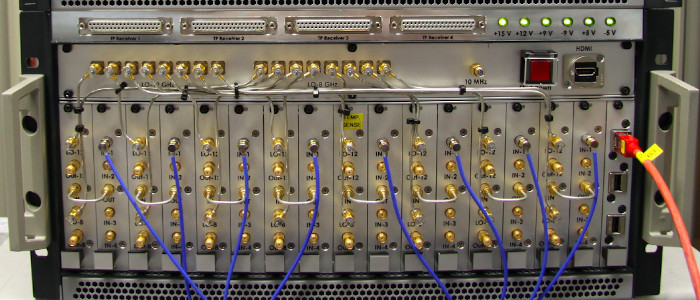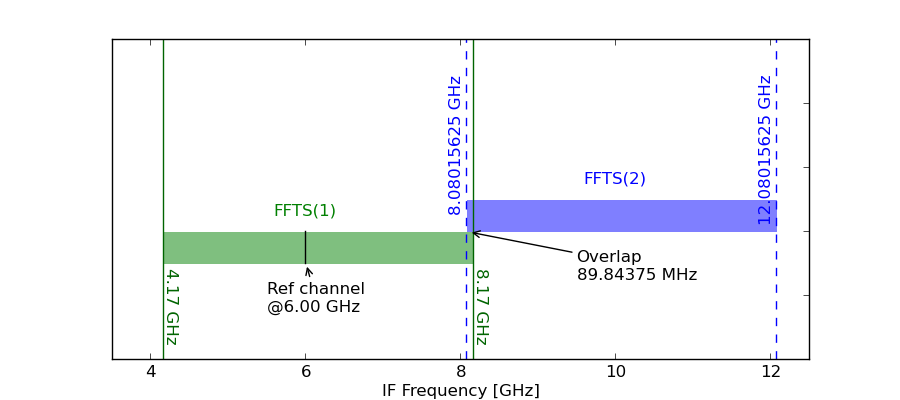APEX IF processor
The Apex-IF (called IF1) is the link between the outputs of the heterodyne receivers in the Nasmyth-A cabin and the FFTS spectrometers. The Apex-IF installed in 2019 can process 8 x 8 GHz input bandwidth in the IF frequency range of 4-12 GHz. The nominal input power level is -23 dBm ± 10 dB.
Because current MPIfR FFTS boards can analyse signals in the frequency range 0-4 GHz (baseband), the Apex-IF divides the 8 GHz input bandwidth into two 4 GHz wide bands. These two 4 GHz wide bands are then transferred to the baseband (0-4 GHz) in a heterodyne mixing process.
The Apex-IF has a modular design. Each IF-module converts the 8 GHz input bandwidth into 2 x 4 GHz for the FFTS. An additional switch module with 4 inputs each was placed in front of each of the eight IF-modules to allow the Apex-IF to be switched between different receivers. The switching is realised by pin diode switches to avoid contact problems, as often observed with mechanical switches.

A complete auto-level process including data exchange with the FFTS can be performed within one second. Because this process is possible for all IF modules in parallel, the time for an auto-level does not increase even if the complete Apex-IF is levelled with 8 IF modules.
In practice, the IF1 filters the ranges 4.17 to 8.17 GHz and 8.08015625 to 12.08015625 GHz. Effectively, this gives a total bandwidth of 7.91 GHz and an overlap of the two spectrometers of 89.8 MHz. These specific frequencies have been chosen to align the channels in the two spectrometers no matter how the channel binning is chosen.

FFTS spectrometers
The new Apex-FFTS is based on the FFTS developments carried out at the MPIfR in Bonn over the last 15 years. It uses the 4th generation FFTS technology called dFFTS4G boards. These boards have been successfully used in the upGREAT receiver on board of SOFIA.
At APEX the dFFTS4G boards are in operation in both the Nasmyth-A cabin for the facility instrument as well as in the Nasmyth-B cabin as part of the digital back-end for the PI receivers from MPIfR.
Eight dFFTS4G boards are integrated into a 19″ wide crate, which allows the FFTS to process a total bandwidth of 8 x 2 x 4 GHz = 64 GHz. At the highest spectral resolution of 64k at 4 GHz, the total number of spectral channels is 8 x 2 x 64k = 1024k (one million channels).

Considerations for observations
For both cabins, the tuning frequency is mapped to IF frequency 6.0 GHz. For the instruments in the B cabin this lies in the centre of the 4-8 GHz band. However, for the instruments in the A cabin the tuning has to be shifted by 170 MHz in order to centre a particular frequency inside the 4-8 GHz band. Similarly if one wants to centre a line in the 4-12 GHz IF section, the tuning needs to be shifted by 2125 MHz. These frequency shifts have opposite signs depending on whether one has an LSB or USB tuning.
One needs to consider that in the overlap region of the spectrometers (also at the outer edges) aliasing is present. This effects produces that a strong line that would lie at a frequency just outside the spectrometer edge, would be mirrored (with some attenuation) around the band edge. For this reason, it is strongly recommended to avoid placing the brightest or most important lines of study close to the band’s edge. Also, we suggest that ~1% of the bandwidth at each edge is excluded at the initial stage of the data reduction.